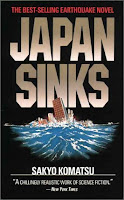 Author: Sakyo Komatsu
Author: Sakyo Komatsu
Translator: Michael Gallagher
U.S. publisher: Kodansha
ISBN: 9784770020390
Released: September 1995
Original release: 1973
Awards: Mystery Writers of Japan Award, Seiun Award
Sakyo Komatsu is considered to be one of Japan’s masters of science fiction and is highly regarded as an author. Probably his most well-known and influential work was Japan Sinks, an earthquake disaster novel that he wrote between 1964 and1973. Published in Japan in 1973, Japan Sinks earned Komatsu both a Mystery Writers of Japan Award and a Seiun Award. The novel has since inspired a sequel (which Komatsu coauthored with Kōshū Tani), two live-action films, a television series, and even a manga adaptation by Takao Saito. Michael Gallagher’s abridged English translation of the novel was first published by Harper & Row in 1976 and became the basis for translations in eleven more languages. Kodansha International brought the novel back into print in 1995 with an additional author’s note from Komatsu. Unfortunately, that edition has gone out of print as well and Japan Sinks is now somewhat difficult to find—a shame for such a notable work.
Earthquake and tsunamis are not unusual occurrences in Japan. They are something that the country has faced for centuries and has made preparations to deal with. But an increase in seismic and volcanic activity has many scientists concerned, especially when an entire island off the southern coast of Japan disappears over night. An investigation is subsequently launched into the incredible event. As hard as it is to believe, the island has sunk. What is even more terrifying is the discovery of unprecedented tectonic plate movements that will result in increasingly violent and destructive earthquakes and volcanic eruptions. It is theorized that within a few years the entire Japanese archipelago will be lost. The real question is what can be done about Japan’s impending doom. The geological event cannot be stopped, but no one wants to believe that it will actually happen, either.
The narrative in Japan Sinks is a bit disjointed, particularly early on in the novel. I assume this is at least in part due to the abridgement, but I’m not entirely sure how much or even what was cut from the original Japanese edition of Japan Sinks. The beginning of the novel seems like a sequence of scenes that aren’t directly related, but most are eventually revealed to be needed for the story as a whole. It’s as if the connecting material is missing, though. However, as the novel progresses, the disparate story elements are tied together. By the end of Japan Sinks the only things that seemed tacked on and largely unnecessary were the romantic subplots; I can only imagine that these were more thoroughly developed in the original, but once again I’m not certain. For the most part, the unconnected nature of the storytelling was only a minor annoyance.
Although the narrative is somewhat fragmented, there is one thing that Komatsu excels at in Japan Sinks—he takes into consideration all aspects of the impending crisis in a very realistic way. The story is solidly based in real science, which makes it all the more terrifying. Komatsu explores the political maneuverings, both national and international, that are involved in dealing with the disaster as well as its economic implications. The scope of Japan Sinks is both global and personal, but I found the novel to be most engaging when it focused on the experiences of individuals. Granted, these sections were so effective because they took place within a greater context. Widespread death and destruction takes on more significance when it is known what it means for a single person as well as for a country as a whole. Japan Sinks addresses all of these issues and as a result the novel is a chilling account.
